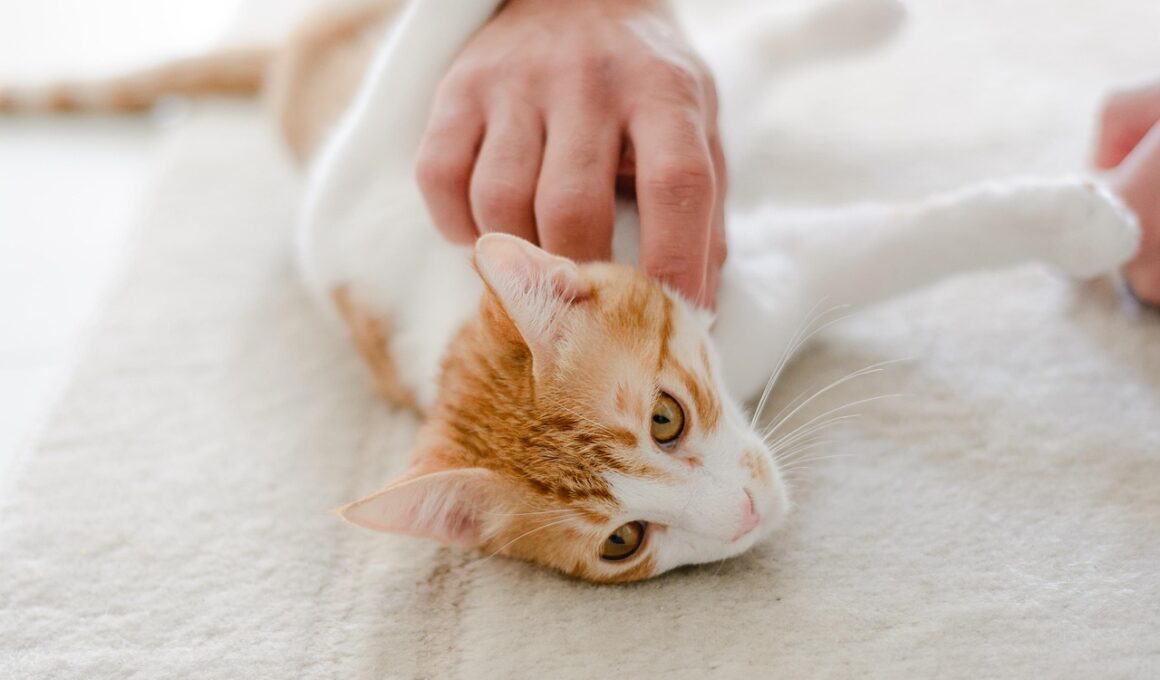The Role of Hygiene in Managing Cat Allergies to Humans
Managing cat allergies to humans is a multifaceted challenge where proper hygiene plays a crucial role. Cats naturally produce proteins found in their skin, saliva, and urine, which can trigger allergic reactions. To minimize the spread of allergens, it is essential to maintain a clean living environment. Regular cleaning routines should include vacuuming carpets and upholstery where allergens may accumulate. Additionally, using air purifiers equipped with HEPA filters can significantly reduce airborne allergens. Bathing cats regularly can help lower the quantity of dander they shed, thus reducing the likelihood of allergic reactions occurring. For individuals with known sensitivities, minimizing direct contact with the cat can also be helpful. Additionally, try to keep the litter box clean and use dust-free litter. Consider restricting the cat’s access to certain areas, especially bedrooms where a person may be particularly vulnerable. Overall, understanding that hygiene is a key factor can empower pet owners and allergy sufferers alike to manage their environment effectively. Combining these approaches creates an atmosphere that is healthier and can improve the quality of life for both cats and their human companions.
In the context of cat allergies, understanding allergen distribution is vital to effective hygiene management. Allergens can travel through the air and settle on surfaces, contributing to allergic reactions. To combat this, implement a strict cleaning schedule. Dust and vacuum your home at least once a week, ensuring the use of a vacuum cleaner with a HEPA filter, effective at trapping fine particles. Regularly wash curtains, throws, and cushions to eliminate dust accumulation. Pay particular attention to areas where the cat sleeps, as they can become hotspots for allergens. It’s essential to avoid using feather pillows or down comforters, as these can harbor allergens. A proactive approach to managing allergens and maintaining hygiene creates a more comfortable living space. It is beneficial to involve family members in these efforts for consistency. Educating them on the importance of clean spaces will lead to better results. Moreover, incorporating washable surfaces and materials throughout your home will simplify the cleaning process. Ultimately, by keeping allergens contained and controlled, you can significantly reduce the chances of triggering allergic reactions, making life easier for both you and your feline friend.
Essential Hygiene Practices
Establishing essential hygiene practices is necessary to manage cat allergies more effectively. One effective method is to create designated cat-free zones in your home. For instance, consider making bedrooms and home offices off-limits to your cat. This precaution can help minimize exposure to allergens in spaces where you spend considerable time. Additionally, invest in washable slipcovers for your furniture. This allows for regular cleaning and helps trap allergens that may linger on surfaces. Another hygiene tip is to use damp cloths to wipe down surfaces instead of dry dusting, which can stir allergens into the air. Implementing a no-shoes policy can also be beneficial, as shoes can bring in outdoor allergens that worsen the situation. Furthermore, keep your cat’s grooming routine consistent, and regularly brush them outdoors to manage loose fur and dander. Using a fine-toothed comb can be particularly effective in catching loose hair. Utilizing these hygiene practices can significantly reduce the presence of allergens in your home. Ultimately, the aim is to create a clean, controlled environment where both you and your cat can thrive without triggering allergic responses.
Maintaining proper air quality in your home is another critical aspect of managing cat allergies. Indoor air may be filled with allergens, so investing in a good ventilation system will contribute positively. Opening windows can help circulate fresh air, particularly during weeks with lower pollen counts. In addition, the strategic use of air purifiers can help eliminate allergens present in the air. Opt for devices equipped with HEPA filters that trap tiny allergenic particles, making your environment healthier. Moreover, consider implementing houseplants, which can improve air quality throughout your living space. However, select non-toxic plants, as some can be harmful to cats. Regularly replace air filters in heating and cooling systems to ensure optimal performance. Adding a humidifier can also aid in alleviating symptoms of allergies by keeping moisture levels balanced. Keeping indoor humidity between 30-50% can help prevent the spread of allergens. Managing your indoor air quality through these methods creates a safer environment for both you and your cat. By ensuring that your home is filled with clean, allergen-free air, you stand a better chance of reducing allergy flare-ups.
The Importance of Regular Vet Visits
Regular veterinary check-ups are essential for monitoring your cat’s health, especially if they interact with allergy-sensitive individuals. Annual visits provide opportunities for vaccinations and addressing any underlying health issues that may exacerbate allergic reactions. A veterinarian can suggest appropriate dietary changes to help reduce allergenic reactions attributed to your kitty. Furthermore, regular health check-ups can help in identifying any medical conditions that may impact coat condition, shedding, or dander production. Cats with a healthy coat shed less and can reduce the volume of allergens in your living environment. Preventative care, such as flea control and parasite management, protects not only the cat’s health but also limits potential allergens from fleas and ticks. Open discussions with your vet about allergies in humans and understanding how your cat might contribute are crucial steps. They can provide additional insight into effective ways to minimize allergens. Actively involving your veterinarian in your allergy management plan is invaluable for ensuring both feline and human wellness. Through veterinary assistance, you can tailor strategies that cater to the specific needs of both you and your cat.
Consider seeking professional cleaning services that specialize in allergy management if the task feels overwhelming. These experts may use advanced cleaning solutions and methods that are more effective in reducing allergens than standard home cleaning. Steam cleaning carpets, upholstery, and curtains can significantly impact allergen levels. Deep cleaning carpets eliminates any lingering dander and dust that vacuuming alone might not address. Alternatively, consider transitioning to hardwood or tile floors, which are less likely to trap allergens compared to carpets. If you opt for rugs, choose materials designed to repel allergens. Be aware that some cleaning supplies can be irritating to allergic individuals, so choose hypoallergenic cleaning products. In addition, educate family members about potential allergens, encouraging them to maintain cleanliness in communal areas. Creating routines together for cleaning can promote a collective responsibility for hygiene. Ultimately, enlisting professionals, using proper techniques, and making informed material choices can improve the overall cleanliness of your home. This determination can lead to a healthier and more enjoyable living environment for everyone, including your beloved feline friend.
In Conclusion
Caring for a cat while managing allergies requires dedication, persistence, and the implementation of best hygiene practices. Cat allergens can be a significant concern for many, but they can be managed effectively through conscientious efforts. Regularly maintaining a clean and allergen-free environment ensures comfort for both pets and humans. Investing time in grooming, cleaning, and professional assistance, if necessary, contributes to minimizing allergic responses. Ensure that your home is a sanctuary free from allergens by consistently applying the mentioned strategies. It is also crucial to educate family members about the impact of cat allergens and hygiene so everyone is on the same page. Regular health checks for your cat will enhance your shared life, allowing both you and your pet to enjoy a happy and healthy existence. Through teamwork, understanding, and commitment, living with cats when sensitive to allergens is possible. Keeping communication open between you, your family, and your veterinarian can lead to the most favorable outcomes. Ultimately, your dedication to creating a safe and clean living environment benefits both human and pet life.
As you implement these strategies, remember that patience is key to managing cat allergies effectively. Allow time for improvements in the living space and monitor changes in allergy symptoms closely. Document any reactions and adjustments made to better understand what works and what doesn’t. This commitment to trial and error can lead to significant improvements in quality of life for those affected by allergies. Regularly reassess cleaning techniques and adjust routines as necessary. Engaging with online communities may provide additional insights and tips from those in similar situations. They can share their experiences and solutions that have proven beneficial in managing their cat allergy issues. Additionally, consider consulting with an allergy specialist for personalized advice tailored to your circumstances. Finding the right approach to managing cat allergies is a unique journey and may require specific solutions that fit your lifestyle. By taking proactive measures and continuously learning, you’ll pave the way towards creating a pleasant coexistence with your furry companion. Ultimately, an informed and diligent approach allows you to enjoy your cat while minimizing allergy impacts, improving health, and fostering a loving relationship.


